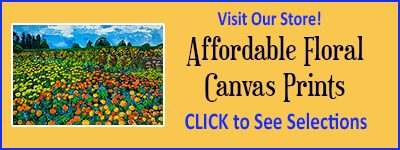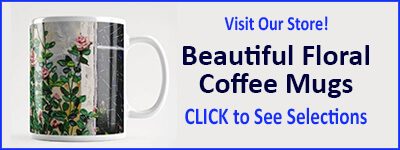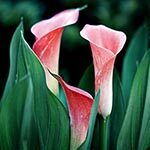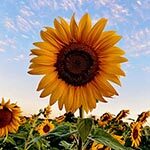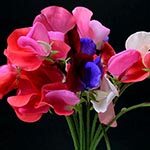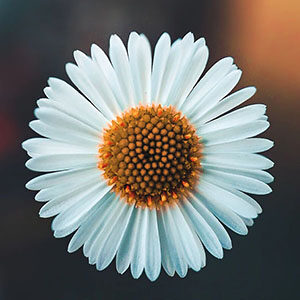
Daisy Flower Meaning
Fascinating Stories, Popular Culture & Symbolism
Daisy flower meaning is purity, innocence, loyal love, faith, beauty, patience and simplicity. Daisies are often depicted in meadows in medieval paintings. Such a meadow is known as a “flowery mead.” Daisies are non-fragrant flowers that originated in Africa.
Share this page with a friend!
Ancient Depictions of Daisy Flowers
Daisies are believed to be more than 4,000 years old. Hairpins decorated with daisies were found during the excavation of the Minoan Palace on the Island of Crete. Even further back, Egyptian ceramics were decorated with daisies.
Watch nearly 400 videos on the Vocal Medicine Channel!
Daisy Flower Name Meaning
Botanical Origin of Daisies
The family Asteraceae (known as the aster, daisy, or sunflower family) is the largest family of flowering plants. The name Asteraceae is derived from the type genus Aster, meaning star. The family comprises more than 1,600 genera and 23,000 species. Asteraceae are most common in the temperate regions and tropical mountains.
Origin of Daisy Flower Name
Some believe the name daisy come from “day’s eye” because the flower is only open during the day and closes up at night. Another name is Thunderflower since it blooms in the summer when thundershowers are common. There are many alternate names for daisies including Ox-Eye, Goldens, Marguerite, Moon Daisy, Gowan, Baldur’s Brow, Maudlinwort, and Corn Marigold.
Daisy Flower Superstitions
In addition, the daisy is believed to keep away lightening. For this reason, it was kept indoors as well as in gardens. A common name in England for the flower is Bruisewort since the crushed leaves could be used for soothing bruised or chapped skin.
Slang References to Daisies
The word “daisy” has made its way into slang words and phrases. In the 1800s, the phrase “ups-a-daisy” was commonly used to encourage children to get up when they fell. This eventually transformed into “oopsy daisy” or “whoops-a-daisy” — an exclamation after a stumble or mistake.
Spiritual Meaning of Daisies
Roman Mythology of Daisies
The spiritual meaning of daisies vary from culture to culture. Romans associated daisies with the story of Belides, a nymph who was being pursued by Vertumnus, the god of seasons and gardens. To get away from his unwanted attention, she turned herself into a daisy. This is the source of the flower’s Latin name, Bellis.
Daisy Meanings in Norse Mythology
In Norse mythology, daisies are associated with Freya, the goddess of love. In this context, the daisy symbolizes motherhood, childbirth, sensuality, and fertility. Freya is the wife of the god Odin. Odin is the god of war and of the dead. He is the lord of Valhalla, the eternal home of slain warriors. Legends claim that Odin was away from Freya extensively as he traveled the world. As a result, Freya mourned his absence. Daisies are said to be created from Freya’s tears.
Daisies in Celtic Mythology
For the ancient Celts, the spiritual meaning of a daisy comes from the belief that if a child dies, the gods will sprinkle their grave with daisies to comfort the grieving parents. Daisies are also associated with the sun, especially at summer solstice. The form of daisies reflect the rays of the sun, bringing light to the earth. in this way, daisies symbolize good luck and prosperity.
Meaning of Daisies in Ancient Egypt
The Egyptian god Horus is often depicted carrying a bouquet of daisies. In this context, daisies represent fertility and good luck. For the Egyptians, daisies also symbolize joy and innocence. Horus is the Egyptian sky god, the only child of Osiris and Isis. Horus is depicted with the head of a falcon and a man’s body. Horus is married to the goddess Hathor.
What Do Daisies Represent?
Christian Daisy Flower Meaning
In the Christian tradition, daisies have been used in Mary Gardens. These are symbolic gardens created in honor of the Virgin Mary. The gardens served as places for meditation on the graces of Mary, the mother of Jesus. The daisy is also symbolically connected to St. John.
Magical Daisy Flower Meaning
Daisies are associated with the planet Venus in the world of magic and pagan traditions. They are connected to the water element and are feminine versus masculine. Learn more about the five elements of nature and determine your own element affinity in Five Element Mantras.
Daisy Flower Meaning in Love
Daisies are composite flowers, meaning that they actually consist of two flowers combined into one. The inner section is called a disc floret, and the outer petal section is called a ray floret. Because daisies are composed of two flowers that blend together so well, they symbolize true love or loyal love. Daisies are also the April birth month flower, a popular month for spring weddings.

Daisy Flower Color Meanings
The daisy that most people think of is the classic white Gerbera daisy. Daisies also come in pink, red, yellow and blue or violet. Daisies are the fifth most popular cut flower around the world.
White Daisy Flower Meaning
White flowers generally symbolize purity, contemplation and innocence. Many night-flowering plants are white, symbolizing the feminine energies of the moon. White lowers include daisies, daylilies, gardenias, alyssum and baby’s breath. Use white to give breathing space in your garden from the intensity of bright colors. White daisy color meaning is particular connected to the association of daisies with purity and simplicity.
Yellow Daisy Flower Meaning
Yellow flowers are the heralds of spring. Sunshine yellow flowers symbolize the clearing away of the winter and stimulate clear thinking. Well-known yellow flowers include daisies, daffodils, crocus, irises, daylilies, coneflowers, dandelions and chrysanthemums. The daisy color meaning for yellow is enthusiasm, cheerfulness, sense of humor, fun, optimism and intellectuality. Yellow and white daisies combine well with other flowers in gardens.
Pink Daisy Flower Meaning
Pink daisy color meaning symbolizes love and healing from grief, anxiety or emotional trauma. Other pink flowers include chrysanthemums, irises, daylilies, camellias, azaleas, carnations, peonies and dahlias. Pink is related to warmth and love, gentleness, beauty, and an outward orientation.
Blue Daisy Flower Meaning
Blue flowers symbolize the peace of ocean and sky. The impact of blue flowers is cooling and calming. As a general meaning, blue symbolizes water, the source of life. Daisy color meanings for blue flowers are related to freedom, strength and new beginnings. Blue skies mean optimism and better opportunities.
Daisy Meaning in Movies and Literature
Daisy References in Movies
The term “daisy” is English slang for something excellent or appealing. This term made an appearance in 1993 Doc Holliday film Tombstone in which he uses phrases like, “You’re no daisy. No daisy at all.”
Daisy Flower Meaning in Poetry
Daisy symbolism has also inspired renowned poets throughout history. For example, Wordsworth praised the daisy in his popular poem To the Daisy: “But now my own delights I make, My thirst at every rill can slake, And gladly Nature’s love partake, Of Thee, sweet Daisy!”
Daisy Flower Meaning in Shakespeare
Shakespeare used a daisy chain in Hamlet to represent Ophelia’s innocence. In addition, when Ophelia hands out flowers to members of the court, she announces the daisy but does not give any away. This indicates that she does not believe there is any innocence in the court members.
Famous Songs Using the Name Daisy
In 1892, Daisy Bell (Bicycle Built for Two) was written by Harry Darce. The song is purported to be about Daisy Greville, one of the many mistresses of King Edward VI. The song was an immediate hit when performed at the Atlantic Gardens on the New York Bowery that year.
Daisy Bell (Bicycle Built for Two)
The song was later recorded by Nat King Cole on his 1963 album Those Lazy-Hazy-Crazy Days of Summer. The chorus of the song is a light-hearted proposal: “Daisy, Daisy, give me your answer do; I’m half crazy all for the love of you; It won’t be a stylish marriage; I can’t afford a carriage; But you’ll look sweet upon the seat of a bicycle built for two.”

Culinary and Medicinal Uses of Daisies
Daisies can be eaten and are even medicinal. Daisy leaves are a common addition to salads. Daisies are easy to find through foraging. Wild daisy tea is used to treat coughs, bronchitis, inflammation, and more. Wild daisies are also sometimes applied to the skin for wounds and diseases.
Food Crops in the Daisy Family
Commercially important plants in the daisy family include the following food crops: lettuce, chicory, globe artichoke, sunflower, safflower, and Jerusalem artichoke. Other commercially important species include flowers used as herbs and in herbal teas and other beverages.
Daisy Flowers in Popular Teas
Chamomile and calendula are grown commercially for herbal teas and the potpourri industry. Echinacea is used as a medicinal tea. Modern analysis has found that daisies contain nearly as much vitamin C as lemons!
Scientific Studies of Daisy Flowers
A research study published in 2012 also appears to confirm the medicinal properties of daisy. This study found that 100% of the wounds treated on rats with an extract of daisy healed perfectly without any scarring. The researchers concluded “Thus, traditional usage of wound healing activity… was scientifically verified for the first time.”
History of the Gerbera Daisy
Daisy Flowers in the United Kingdom
In the year 1727, the Gerbera daisy variety was discovered in Africa by Jan Gronovius. Jan decided to name the Gerbera flower after his colleague, a German botanist and medical doctor, Traugott Gerber. In 1827, the flower was introduced to the United Kingdom. There the production was further refined and cultivated.
Daisies in the Netherlands
In 1950, the Netherlands became the largest country in the field of development for the Gerbera flowers. Moving forward to the year 1975, the Gerbera daisy became a very popular cut flower. The daisy is now exported extensively due to high demand.
Other Popular Types of Daisies
Cape Daisy
The Cape daisy is also known as the Cape marigold, Cape margeurite or African daisy. Cape daisies have two overlapping rows of petals. They are available all year and have a notably long vase life.
Shasta Daisy
The Shasta daisy is a classic daisy that loves full sun to light shade. As a perennial, these daisies will come back every year in the spring or early summer. They can be aggressive and spread to wild areas if not properly contained in your garden.
Australian Paper Daisy
Paper daisies are also known as straw flowers. The Paper daisy is used for tea purported to aid in stress-release and weight reduction. The crushed leaves can also help to heal wounds. These daisies also have a long life as cut flowers.
Gloriosa Daisy
Gloriosa daisies will help to attract bees and butterflies to your property. Gloriosa daisies are commonly called Black-Eyes Susan. They are easy to grow and have a dark brown or black center. Grown from seed, they have a large bloom (5 to 9 inches).
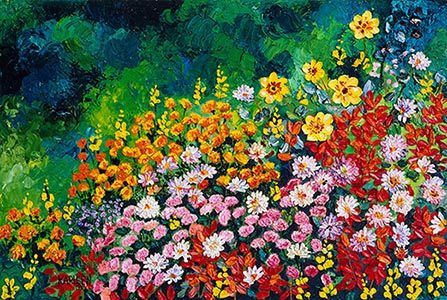
Available as an affordable floral canvas print at Vocal Medicine Gifts.
Daisy Flowers for Meaningful Gifts
Daisy Flowers for Baby Gifts
Daisy themed gifts are fantastic for baby showers and gifts for newborns. This connects to their symbolic meanings of purity and innocence. Daisies are often used to decorate clothing for infant girls and toddlers. Daisy prints and posters also work well in nurseries and children’s bedrooms.
Special Daisy Occasions
Daisies are the flower for the month of April. They make perfect gifts for anyone born in this month! They are also the flower for a 5th wedding anniversary.
Daisies for Get Well Gifts
Cheerful daisies are a bright and encouraging gift for anyone recovering from illness. Daisies can last up to 14 days after cutting if cared for properly: Cut the stems at an angle for better water absorption. Remove any leaves that would be below the water line and might rot. Change water every couple of days if it becomes cloudy. Recut the stems every couple of days.
Daisy Flowers in Artwork
Abundant flowers including daisies work well for prints and posters in offices, family rooms and places for happy gatherings. Depictions of beautiful flowering meadows popular in Medieval days has never gone out of style.
Habitat and Botany of Daisies
Daisies are a perennial flower that grow on stems up to 112 inches in length. Wild daisies grow on grasslands, roadsides and lawns. The leaves of a daisy flower are alternate and lance-shaped. Daisies thrive under a wide range of conditions, preferring heavy, damp soils.
Daisy Range and Spread
Daisies are widespread in Europe and the temperate regions of Asia. Daisies have also become a common weed in North America, Australia and New Zealand. Daisies bloom from late spring until late summer. Too much shade will inhibit flowering. Daisies need at least six hours a day of sun.
More Related Flower Articles
DAISY MEANING ARTICLE SUMMARY
Daisy meaning goes back thousands of years. The name origin and spiritual meaning of daisies are covered in this article as well as medicinal uses, culinary uses, and daisy meaning in literature and songs. Also included is daisy meaning based on color.
Author Kathleen Karlsen
Kathleen Karlsen is a musician, artist, writer and speaker. She is the author of two books (Flower Symbols and Vocal Medicine) and over 200 articles. Kathleen, her husband Andrew, and their five children live in Bozeman, Montana. More about Kathleen Karlsen.


